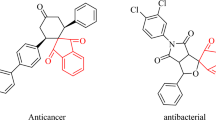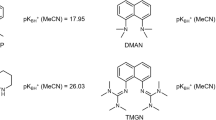Abstract
Multiarmed functional cyclosiloxanes were obtained via a facile synthesis through the photocatalytic thiol-ene reaction of 1,3,5-trivinyl-1,3,5-trimethylcyclosiloxane (D3V), 1,3,5,7-tetravinyl-1,3,5,7-tetramethylcyclosiloxane (D4V), and 1,3,5,7,9-pentavinyl-1,3,5,7,9-pentamethylcyclosiloxane (D5V) with cysteamine hydrochloride under mild conditions. A subsequent desalting reaction with triethylamine was conducted to obtain amine-functionalized cyclosiloxanes with ring structures (D4A and D5A). The chemical structures were confirmed by nuclear magnetic resonance, Fourier transform infrared spectroscopy, and matrix-assisted laser desorption ionization time-of-flight mass spectra. The regioselectivities of the final products were determined with β-adducts as high as 93% irrespective of the number of cyclosiloxane rings. The amino-functionalized cyclosiloxane monomers underwent a mild Schiff base reaction to obtain hybrid networks. Their morphologies, thermal properties, and porosities were also investigated.
This is a preview of subscription content, access via your institution
Access options
Subscribe to this journal
Receive 12 print issues and online access
$259.00 per year
only $21.58 per issue
Buy this article
- Purchase on Springer Link
- Instant access to full article PDF
Prices may be subject to local taxes which are calculated during checkout







Similar content being viewed by others
References
Qing G, Cui C. Controlled synthesis of cyclosiloxanes by NHC-catalyzed hydrolytic oxidation of dihydrosilanes. Dalton Trans. 2017;46:8746–50.
Dankert F, von Hänisch C. Siloxane coordination revisited: Si−O bond character, reactivity and magnificent molecular shapes. Eur J Inorg Chem. 2021;2021:2907–27.
Shim JS, Asthana S, Omura N, Kennedy JP. Novel thermoplastic elastomers. I. Synthesis and characterization of star-block copolymers of PSt-b-PIB arms emanating from cyclosiloxane cores. J Polym Sci A Polym Chem. 1998;36:2997–3012.
Itami Y, Marciniec B, Kubicki M. Functionalization of vinyl-substituted cyclosiloxane and cyclosilazane via ruthenium-catalyzed silylative coupling reaction. Organometallics. 2003;22:3717–22.
Demirci A, Yamamoto S, Matsui J, Miyashita T, Mitsuishi M. Facile synthesis of cyclosiloxane-based polymers for hybrid film formation. Polym Chem. 2015;6:2695–706.
Sun R, Feng S, Zhou B, Chen Z, Wang D, Liu H. Flexible cyclosiloxane-linked fluorescent porous polymers for multifunctional chemical sensors. ACS Macro Lett. 2020;9:43–48.
Kim S, Zhu H, Demirci A, Yamamoto S, Miyashita T, Mitsuishi M. Cyclosiloxane polymer bearing dynamic boronic acid: synthesis and bottom-up nanocoating. Polym Chem. 2019;10:5228–35.
Zhu H, Akkus B, Gao Y, Liu Y, Yamamoto S, Matsui J, et al. Regioselective synthesis of eight-armed cyclosiloxane amphiphile for functional 2D and 3D assembly motifs. ACS Appl Mater Interfaces. 2017;9:28144–50.
Zhu H, Buchtal TJ, Mitsuishi M. Self-assembling superstructures of cyclosiloxane amphiphiles with complex flower shapes and superhydrophobic properties. Appl Surf Sci. 2021;563:150245.
Zhu H, Demirci A, Liu Y, Gong J, Mitsuishi M. Robust, reusable, and antioxidative supramolecular adhesive to inorganic surfaces based on water-stimulated hydrogen bonding. ACS Appl Polym Mater. 2022;4:1586–94.
Zheng P, McCarthy TJ. Rediscovering silicones: molecularly smooth, low surface energy, unfilled, UV/Vis-transparent, extremely cross-linked, thermally stable, hard, elastic PDMS. Langmuir. 2010;26:18585–90.
Song Y, Chen X, Liang YN, Zhang L, Liu M, Hu X. Bio-inspired reinforcement of cyclosiloxane hybrid polymer via ‘molecular stitching’. Chem Eng J. 2019;368:573–6.
Liu Y, Demirci A, Zhu H, Cai J, Yamamoto S, Watanabe A, et al. A versatile platform of catechol-functionalized polysiloxanes for hybrid nanoassembly and in situ surface enhanced Raman scattering applications. J Mater Chem C. 2016;4:8903–10.
Prigyai N, Chanmungkalakul S, Thanyalax S, Sukwattanasinitt M, Ervithayasuporn V. Cyclic siloxanes conjugated with fluorescent aromatic compounds as fluoride sensors. Mater Adv. 2020;1:3358–68.
Gou Z, Wang A, Tian M, Zuo Y. Pyrene-based monomer-excimer dual response organosilicon polymer for the selective detection of 2,4,6-trinitrotoluene (TNT) and 2,4,6-trinitrophenol (TNP). Mater Chem Front. 2022;6:607–12.
Sinha AK, Equbal D. Thiol−Ene reaction: synthetic aspects and mechanistic studies of an anti-Markovnikov-selective hydrothiolation of olefins. Asian J Org Chem. 2019;8:32–47.
Bordoni AV, Lombardo MV, Wolosiuk A. Photochemical radical thiol–ene click-based methodologies for silica and transition metal oxides materials chemical modification: a mini-review. RSC Adv. 2016;6:77410–26.
Lowe AB. Thiol-ene “click” reactions and recent applications in polymer and materials synthesis. Polym Chem. 2010;1:17–36.
Kim J-S, Yang S, Park H, Bae B-S. Photo-curable siloxane hybrid material fabricated by a thiol–ene reaction of sol–gel synthesized oligosiloxanes. Chem Commun. 2011;47:6051–3.
Saed MO, Terentjev EM. Siloxane crosslinks with dynamic bond exchange enable shape programming in liquid-crystalline elastomers. Sci Rep. 2020;10:6609.
Rózga-Wijas K, Chojnowski J. Synthesis of new polyfunctional cage oligosilsesquioxanes and cyclic siloxanes by thiol-ene addition. J J Inorg Organomet Polym Mater. 2012;22:588–94.
Cole MA, Bowman CN. Synthesis and characterization of thiol–ene functionalized siloxanes and evaluation of their crosslinked network properties. J Polym Sci A Polym Chem. 2012;50:4325–33.
Sprung MA. A summary of the reactions of aldehydes with amines. Chem Rev. 1940;26:297–338.
Segura JL, Mancheño MJ, Zamora F. Covalent organic frameworks based on Schiff-base chemistry: synthesis, properties and potential applications. Chem Soc Rev. 2016;45:5635–71.
Kinoshita S, Watase S, Matsukawa K, Kaneko Y. Selective synthesis of cis–trans–cis cyclic tetrasiloxanes and the formation of their two-dimensional layered aggregates. J Am Chem Soc. 2015;137:5061–5.
Brunauer S, Deming LS, Deming WE, Teller E. On a theory of the van der waals adsorption of gases. J Am Chem Soc. 1940;62:1723–32.
Barrett EP, Joyner LG, Halenda PP. The determination of pore volume and area distributions in porous substances. I. Computations from nitrogen isotherms. J Am Chem Soc. 1951;73:373–80.
Rissing C, Son DY. Thiol−ene reaction for the synthesis of multifunctional branched organosilanes. Organometallics. 2008;27:5394–7.
Engelhardt G, Jancke H. Structure investigation of organosilicon polymers by silicon-29 NMR. Polym Bull. 1981;5:577–84.
Protsak IS, Morozov YM, Dong W, Le Z, Zhang D, Henderson IM. A 29Si, 1H, and 13C solid-state NMR study on the surface species of various depolymerized organosiloxanes at silica surface. Nanoscale Res Lett. 2019;14:160.
Tedder JM, Walton JC. The kinetics and orientation of free-radical addition to olefins. Acc Chem Res. 1976;9:183–91.
Murthy SK, Olsen BD, Gleason KK. Initiation of cyclic vinylmethylsiloxane polymerization in a hot-filament chemical vapor deposition process. Langmuir. 2002;18:6424–8.
O’Shaughnessy WS, Gao M, Gleason KK. Initiated chemical vapor deposition of trivinyltrimethylcyclotrisiloxane for biomaterial coatings. Langmuir. 2006;22:7021–6.
DeBlase CR, Silberstein KE, Truong T-T, Abruña HD, Dichtel WR. β-Ketoenamine-linked covalent organic frameworks capable of pseudocapacitive energy storage. J Am Chem Soc. 2013;135:16821–4.
Segura JL, Royuela S, Mar Ramos M. Post-synthetic modification of covalent organic frameworks. Chem Soc Rev. 2019;48:3903–45.
Kandambeth S, Mallick A, Lukose B, Mane MV, Heine T, Banerjee R. Construction of crystalline 2D covalent organic frameworks with remarkable chemical (acid/base) stability via a combined reversible and irreversible route. J Am Chem Soc. 2012;134:19524–7.
Bae J-Y, Jang J, Bae B-S. Transparent, thermally stable methyl siloxane hybrid materials using sol-gel synthesized vinyl-methyl oligosiloxane resin. J Sol-Gel Sci Technol. 2017;82:253–60.
Chandramohan A, Nagendiran S, Alagar M. Synthesis and characterization of polyhedral oligomeric silsesquioxane–siloxane-modified polyimide hybrid nanocomposites. J Compos Mater. 2012;46:773–81.
Grabowsky S, Hesse MF, Paulmann C, Luger P, Beckmann J. How to make the ionic Si−O bond more covalent and the Si−O−Si linkage a better acceptor for hydrogen bonding. Inorg Chem. 2009;48:4384–93.
Weidenthaler C. Pitfalls in the characterization of nanoporous and nanosized materials. Nanoscale. 2011;3:792–810.
Sing KSW. Reporting physisorption data for gas/solid systems with special reference to the determination of surface area and porosity (Recommendations 1984). Pure Appl Chem. 1985;57:603–19.
Yamamoto M, Goto S, Tang R, Nomura K, Hayasaka Y, Yoshioka Y, et al. Nano-confinement of insulating sulfur in the cathode composite of all-solid-state Li–S batteries using flexible carbon materials with large pore volumes. ACS Appl Mater Interfaces. 2021;13:38613–22.
Tang R, Taguchi K, Nishihara H, Ishii T, Morallón E, Cazorla-Amorós D, et al. Insight into the origin of carbon corrosion in positive electrodes of supercapacitors. J Mater Chem A. 2019;7:7480–8.
Timofeeva TV, Dubchak IL, Dashevsky VG, Struchkov YT. Flexibility of siloxane rings and rigidity of ladder-like siloxane polymers: Interpretation on the basis of atom-atom potential functions. Polyhedron. 1984;3:1109–19.
Acknowledgements
HZ appreciates financial support from the Toyo Suisan Foundation. MM thanks Toshiaki Ogasawara Memorial Foundation for financial support. The authors are also grateful to Prof. Hirotomo Nishihara (Tohoku University) for his kind support with the nitrogen adsorption tests.
Author information
Authors and Affiliations
Corresponding authors
Ethics declarations
Conflict of interest
The authors declare no competing interests.
Additional information
Publisher’s note Springer Nature remains neutral with regard to jurisdictional claims in published maps and institutional affiliations.
Supplementary information
Rights and permissions
About this article
Cite this article
Zhu, H., Watanabe, Y., Yoshida, N. et al. Facile synthesis of amine-substituted cyclosiloxanes via a photocatalytic thiol-ene reaction to generate ketoenamine-linked hybrid networks. Polym J 54, 1257–1265 (2022). https://doi.org/10.1038/s41428-022-00678-0
Received:
Revised:
Accepted:
Published:
Issue Date:
DOI: https://doi.org/10.1038/s41428-022-00678-0



